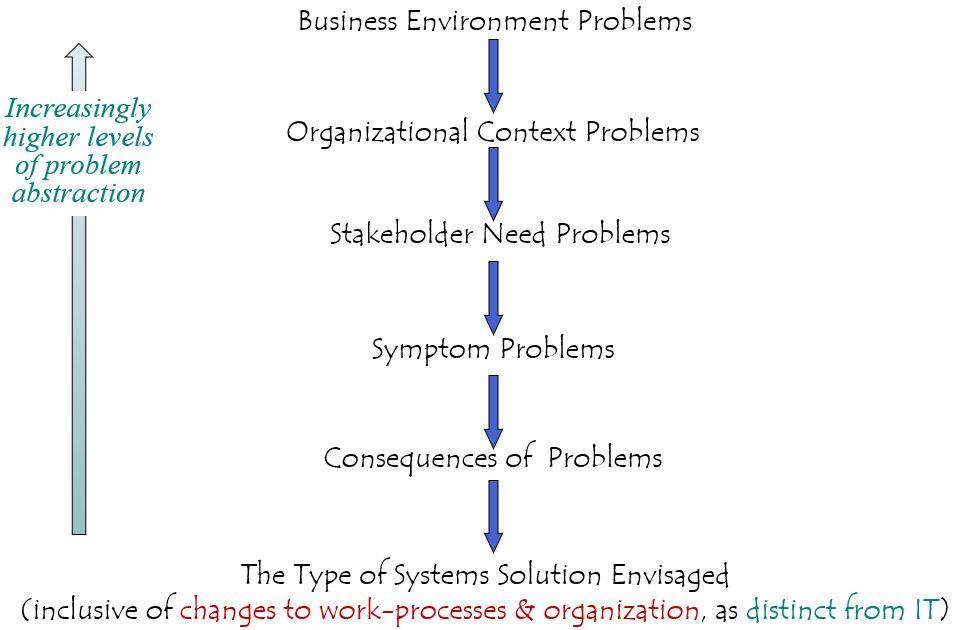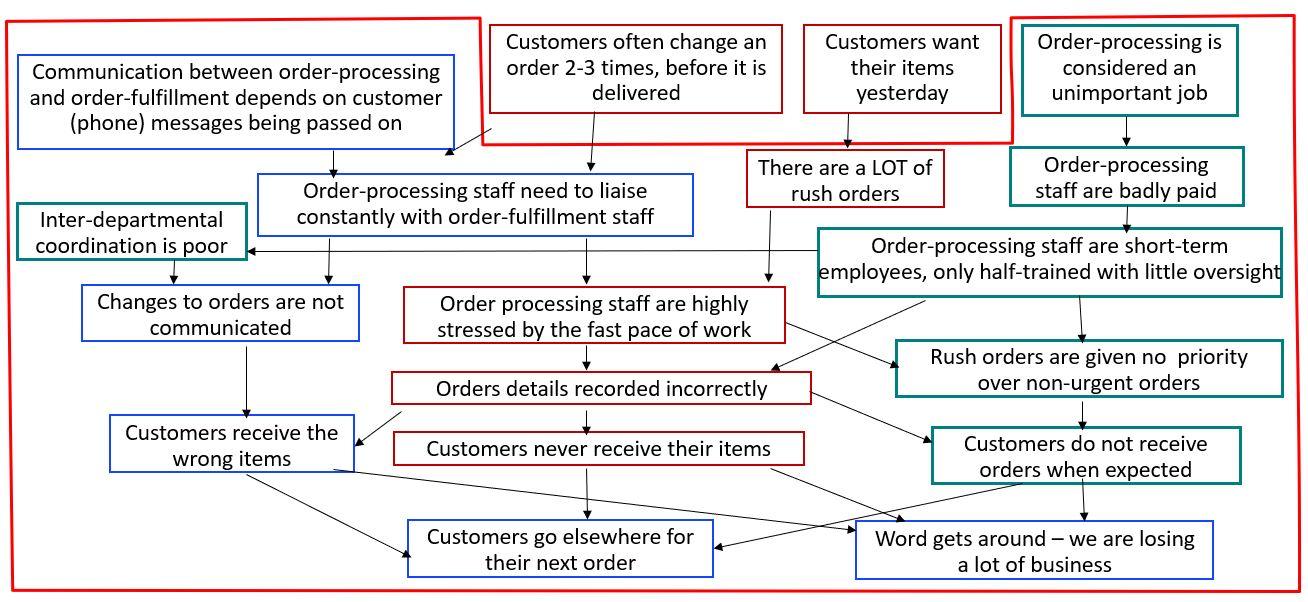We normally start any problem investigation with a stakeholder analysis, where we define the problems experienced by various organizational stakeholders (normally group managers or boundary-spanners) then attempt to reconcile these. To understand the problem, we need to appreciate that any business problem can be modeled at different levels of analysis, as shown in Figure 1.

Figure 1. Various Levels of Analysis, When Investigating Problem Cause-and-Effect
There are two big issues that complicate the analysis of business/organizational problems:
- Most stakeholders will tell you about symptoms – various parts of the bigger problem that they experience – rather than the root-cause problems,that need to be resolved. Integrating these results in a lot of “partial perspectives,” or problem-fragments that it is your job to assemble;
- Stakeholders are not usually aware that what they describe as “the problem” is actually a set of interrelated problems. These need disentangling and separating out.
Typically, IT systems analysts are taught to define requirements for a solution. They are really bad at defining the problem they are trying to solve!
For example, if we employ a problem-statement typically used in requirements analysis, we will get something like:
Initial Problem Statement
| Element | Description |
| The problem of … | Order processing is too slow and prone to human error because this is done manually. |
| Affects … | Customers, order processing staff, order fulfillment staff, complaints staff and managers. |
| The impact of which is … | Orders are not processed in a timely manner, some orders are never dispatched, and some customers receive the wrong items. |
| A successful solution would be … | A system to automate order-processing would eliminate errors, provide more time for order processing staff and order fulfillment staff to get on with their work, and increase customer satisfaction, resulting in more business. |
This problem-statement focuses on how the IT system will function (a typical mistake). If the analyst is questioned, they will state that the problem exists because a process is performed manually, rather than being automated. But when asked what work needs to be automated and why, they are unable to define this. A better definition of the problem focuses on what is not being done effectively. To understand what these problems are, and what causes them, we need to perform a cause-and-effect analysis of order-processing work problems before defining the problems in sufficient detail to solve them. This is shown in Figure 2. It is produced in collaboration with the people who do the work (and their managers). For each problem identified, participants in order-processing are asked “why does that happen?” Issues at each problem-level have multiple causes and multiple consequences.

Figure 2. A Cause-and-Effect Analysis of Order-Processing Problems
As you model problem cause-and-effect relationships, it becomes apparent that some problems are outside the scope of what we can influence. This is indicated by drawing a (red) boundary-line around the problems that we can affect. It also becomes apparent that the problem-elements can be separated into three distinct clusters that are concerned with different causes of the problem. These are outlined in different colors in Figure 3. That analysis allows us to define the “what is not being done effectively?” aspect of the problem in more detail.
Improved Problem Statement: What is not being done effectively?
| Element | Description |
| The problem of … | Order processing is too slow and prone to human error because staff who don’t know what they are doing have no way of recording what has been done to process an order, and no way of tracking the status of an order. |
| Affects … | Customers, order processing staff, order fulfillment staff, complaints staff and managers. |
| The impact of which is … | Orders are not processed in a timely manner, some orders are never dispatched, and some customers receive the wrong items. |
| A successful solution would be … | A system to record and track order-processing activities would eliminate errors, provide more time for order processing staff and order fulfillment staff to get on with their work, and increase customer satisfaction, resulting in more business. |
This definition defines the reason(s) for the problem, in terms of how the system of work is going wrong and why. But conflating the three different aspects of the problem into a single problem-statement makes it difficult to define exactly how to solve it. We get bits of each part of the solution, with no clear way to evaluate if we have solved them all. The giveaway is that the problem-definition has three separate elements that are combined in one single problem-statement. If we separate these out, we get three targeted problem definitions:
Problem Statement 1. Focus on Staff Training and Management
| Element | Description |
| #1: The problem of … | Order processing staff make mistakes and do not process orders according to delivery date order and priority because staff are not trained in effective work procedures and lack any formal oversight mechanisms to ensure that they process orders according to priority and expected delivery date |
| Affects … | Customers, order processing staff, order fulfillment staff, complaints staff and managers. |
| The impact of which is … | Customer dissatisfaction – customers do not receive correct orders, or do not receive orders for which they have paid, because staff do not check order items are correct and complete before dispatch, staff do not process orders to meet delivery dates, and staff are unaware of order priorities. |
| A successful solution would be … | A system to define and manage the rules and priorities for effective order-processing would ensure that staff process orders according to delivery date and priority, increasing customer satisfaction and resulting in more repeat business. |
Problem Statement 2. Focus on Order Recording, Status, and Progress Tracking
| Element | Description |
| #2: The problem of … | Order processing is too slow and processed out of order because there is no way of recording what has been done to process an order, and no way of tracking the status of an order. |
| Affects … | Customers, order processing staff, order fulfillment staff, complaints staff and managers. |
| The impact of which is … | Customer dissatisfaction – orders are not processed in a timely manner, rush orders are not prioritized, some orders are never dispatched, and some customers receive the wrong items. |
| A successful solution would be … | A system to record and track customer order progress would flag orders that have not been processes, communicate order status, and monitor progress, allowing problems to be detected before they affect customers. |
Problem Statement 3. Focus on Coordination of Order Status and Processing Across Departments and Between Individual Staff
| Element | Description |
| #3: The problem of … | Order processing is prone to human error because order processing stages are poorly coordinated between individual staff and across department boundaries. |
| Affects … | Customers, order processing staff, order fulfillment staff, complaints staff and managers. |
| The impact of which is … | Customer dissatisfaction – orders are not processed in a timely manner, rush orders are not prioritized, some orders are never dispatched, and some customers receive the wrong items. |
| A successful solution would be … | A system to communicate the progress of each order would ensure that each order is processed in a timely manner, prioritize rush orders, and coordinate order-processing activities across departments. |
To summarize, each stakeholder will have a different understanding of:
– The core problems and their causes
– The scope of the organization affected (required solution boundary)
– Priorities for change.

